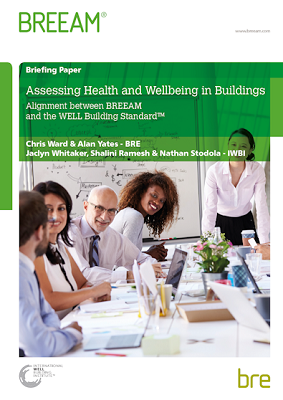Assessing health and wellbeing in buildings
In January 2018, BRE and the International WELL Building Institute pbc (IWBI™) released a new, improved briefing paper that outlines how projects may achieve both a certified BREEAM rating and WELL Certification post-occupation.
Following the 2016 announcement of an agreement between the two organisations to pursue alignments between WELL and BREEAM; the crosswalk document, Assessing Health and Wellbeing in Buildings, was first published in early-2017 to make it easier for those wishing to obtain both a certified BREEAM rating and a WELL Certified™ rating.
The document provides guidance on how the process for pursuing dual certification may be streamlined, and offers information for architects and designers to better understand the requirements and how the two standards relate. It also sets out the areas where WELL requirements are addressed by UK and/or EU regulations, and where these can be omitted from an assessment for buildings undergoing a WELL assessment in these territories.
Specific improvements and enhancements to the guidance document include instructions for projects that clarify how to use the crosswalk, minor amendments to the alignments and overlaps between the two standards, and a simplified labeling system. The new crosswalk also features useful notes and comments to clarify these alignments.
BREEAM and WELL are both evidence-based systems that have best practice, continual improvement and the interest of both the environment and people at their heart. Certification under both systems is pursued through the submission of project documentation and on-site post-occupancy performance testing.
The publication of the briefing paper comes at a time when corporations as well as the real estate industry are increasingly looking at how the built environment impacts human health as well as sustainability.
Alan Yates, BREEAM Technical Director, said: “The document will allow clients and design teams to use the same evidence in both schemes. When you need or want both certification schemes, this document will guide project teams on the most efficient way of going through the process. They won’t need to duplicate evidence or calculate things in different ways, as approximately 35 % of credits are equivalent or aligned in some way. This will ultimately reduce the burden of assessing both schemes.”
This article was originally published here on 1 Feb 2017 by BRE Buzz. It was written by Simon Guy.
--BRE Buzz
[edit] Related articles on Designing Buildings Wiki
- Are we doing the right thing? Shaping well-being into the future of our urban communities.
- BRE Buzz articles on Designing Buildings Wiki.
- BREEAM.
- BREEAM Assessor.
- Building Back Better: Health.
- Building for wellbeing.
- Building up wellbeing in construction.
- Human comfort in buildings.
- Measuring the wellbeing benefits of interior materials.
- Performance in use.
- Phobias.
- The Flourish Model to enhance wellbeing.
- WELL and BREEAM align.
- WELL Building Standard.
- Wellbeing and buildings.
- Wellbeing considerations for property managers.
Featured articles and news
Lighting Industry endorses Blueprint for Electrification
The Lighting Industry Association fully supports the ECA Blueprint as a timely, urgent call to action.
BSRIA Sentinel Clerk of Works Training Case Study
Strengthening expertise to enhance service delivery with integrated cutting-edge industry knowledge.
Impact report from the Supply Chain Sustainability School
Free sustainability skills, training and support delivered to thousands of UK companies to help cut carbon.
The Building Safety Forum at the Installershow 2025
With speakers confirmed for 24 June as part of Building Safety Week.
The UK’s largest air pollution campaign.
Future Homes Standard, now includes solar, but what else?
Will the new standard, due to in the Autumn, go far enough in terms of performance ?
BSRIA Briefing: Cleaner Air, Better tomorrow
A look back at issues relating to inside and outside air quality, discussed during the BSRIA briefing in 2023.
Restoring Abbotsford's hothouse
Bringing the writer Walter Scott's garden to life.
Reflections on the spending review with CIAT.
Retired firefighter cycles world to raise Grenfell funds
Leaving on 14 June 2025 Stephen will raise money for youth and schools through the Grenfell Foundation.
Key points for construction at a glance with industry reactions.
Functionality, visibility and sustainability
The simpler approach to specification.
Architects, architecture, buildings, and inspiration in film
The close ties between makers and the movies, with our long list of suggested viewing.
SELECT three-point plan for action issued to MSPs
Call for Scottish regulation, green skills and recognition of electrotechnical industry as part of a manifesto for Scottish Parliamentary elections.
UCEM becomes the University of the Built Environment
Major milestone in its 106-year history, follows recent merger with London School of Architecture (LSE).
Professional practical experience for Architects in training
The long process to transform the nature of education and professional practical experience in the Architecture profession following recent reports.
A people-first approach to retrofit
Moving away from the destructive paradigm of fabric-first.
New guide for clients launched at Houses of Parliament
'There has never been a more important time for clients to step up and ...ask the right questions'
The impact of recycled slate tiles
Innovation across the decades.
EPC changes for existing buildings
Changes and their context as the new RdSAP methodology comes into use from 15 June.



























